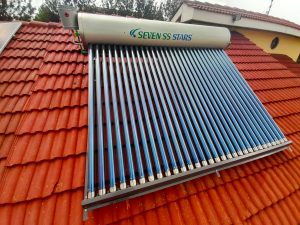How do solar water heaters work?

Imagine waking up to a warm shower powered entirely by the sun! Sounds futuristic, right? Well, it’s not—it’s happening today with solar water heaters. These Eco-friendly systems are revolutionising how we heat water, saving both energy and money. But how do solar water heaters work? Let’s dive into the magic behind them!
How Solar Water Heaters Captures the Sun
Solar water heaters work by using energy from the sun to heat water for domestic or commercial use. Here’s a breakdown of the process:
1.Solar Collectors: Solar water heaters start with solar collectors, usually positioned on the roof. These panels absorb sunlight throughout the day. There are two common types:
- Flat-plate collectors: Durable and effective, these dark panels heat a fluid running through tiny tubes.
- Evacuated tube collectors: More advanced, they trap heat inside vacuum-sealed glass tubes, perfect for cold climates or cloudy days!
2.The Storage Tank: Your Hot Water Vault Once the fluid in the collector heats up, it transfers its energy to water stored in a tank. Whether you’re heating water directly or through a heat-exchange system, the process is fast, efficient, and completely green!
3.Circulation: Keeping the Hot Water Flowing There are two ways the heated fluid makes its way to the storage tank:
- Active Systems: Use electric pumps to circulate the hot water or heat-transfer fluid.
- Passive Systems: No electricity needed! These rely on natural convection (hot water rises, cold water sinks) to move the fluid.
Types of Solar Water Heaters
- Active Systems:
- Direct Circulation Systems: These systems use pumps to circulate water directly from the storage tank to the collectors and back. They are efficient and suitable for areas where freezing temperatures are rare.
- Indirect Circulation Systems: These systems circulate a non-freezing heat-transfer fluid through the collectors, which then heats the water via a heat exchanger. This option is ideal for areas that may experience cooler temperatures.
- Passive Systems:
- Thermosyphon Systems: These rely on natural convection; hot water rises and cold water sinks, eliminating the need for pumps. They are generally more reliable and have lower maintenance costs, making them a good choice for most households in Kenya.
Pressurised systems are more often active, as they use pumps for higher water pressure.
Non-pressurised systems are usually passive, relying on gravity and natural convection for water circulation.
Related Article: Which Solar Water Heating System is Right for You?
Key Considerations
- Household Size and Hot Water Demand: Assess your family’s daily hot water needs. For smaller families (3-4 people), a system with a 100 to 200-litre tank may be enough, while larger families might require 300 litres or more.
- Climate Suitability: Most regions in Kenya have favourable conditions for solar heating due to abundant sunlight. Direct systems with evacuated tubes are particularly popular due to their efficiency in warm climates.
- Roof Characteristics: Ensure your roof can support the weight of the solar system and is oriented to maximise solar exposure. Roofs without shading typically receive more sunlight, enhancing system efficiency.
- Budget: Determine your budget not only for installation but also for maintenance. Passive systems tend to have lower upfront costs and maintenance needs compared to active systems, which can be more expensive but offer higher efficiency.
- Quality and Warranty: Choose reputable brands that offer warranties on their products. A good warranty can provide peace of mind regarding the longevity and reliability of your investment.
Recommendations
- For Smaller Households: Consider a thermosyphon system for simplicity and lower maintenance.
- For Larger Households: An active direct circulation system with evacuated tube collectors may be more efficient, providing sufficient hot water quickly.
- For Budget-Conscious Buyers: A low-pressure passive system can be an affordable entry point into solar water heating without sacrificing too much efficiency.
- Consult Local Experts: Engage with local suppliers or installers who understand the specific conditions in your area. They can provide tailored advice based on your household’s needs and local climate conditions.
By evaluating these factors, you can choose a solar water heater that meets your household’s needs while maximising efficiency and cost savings over time.
For a solar water heating system installation, reach us via:
Phone Number: 0759493610
Email: info@voltmaticenergysolutions.co.ke
